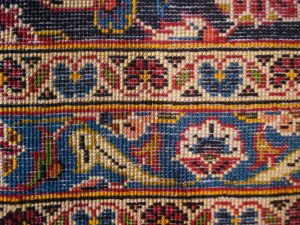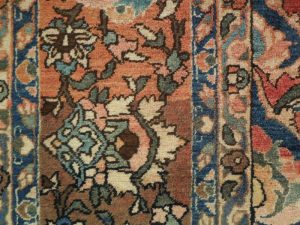The one question uppermost in the mind of most first-time buyers is. “How do I tell the difference between a fake and an authentic oriental rug?” At first glance they look similar and it’s almost impossible to establish fake v/s authentic with just a cursory look. However, a closer look will reveal several tell-tale signs that will help you tell them apart. Read on to find out how you can avoid getting smooth-talked into buying a fake oriental rug.
3 Fundamental Requirements Authentic Oriental Rugs
First and foremost, an authentic oriental rug will meet these three fundamental requirements:
- It should be completely hand-woven
- It should be made using only natural fibers- wool, cotton or silk
- It should be made in any one of these Asian countries – Iran, India, Nepal, China, Pakistan, Russia, Morocco or Afghanistan.
If any one of these is not met, it instantly disqualifies the rug from being categorized as an ‘Oriental rug’. Considering buying a rug labeled ‘machine-made oriental rug’? Such tags can often be misleading. In this case, just by virtue of it being machine-made, it lacks one of the essential requirements and is not an authentic oriental rug. You can read about how to tell the difference between hand knotted and machine made rugs in our characteristics of Oriental rugs post
A Closer Look at the Construction
Take a closer look at the construction of the rug. Check out the design and the weave, both at the front as well as the back. An authentic rug will almost always have imperfections because it is hand-made using wooden looms.
Back of the rug:You should be able to see a horizontal row of weft threads. Usually these horizontal rows are not in perfectly straight lines. They may look a little askew, which is what you want. Take a look at the colored knots too. In an authentic rug, the knots will be unevenly colored and they will be thicker in some areas. Perfectly straight lines and even colorations are signs of a machine made rug.
Front of the rug: Look at the design at the front of the rug carefully. In an authentic rug it is extremely rare that the design will be the exact same shape, size or coloration across the rug. You will see several variations, some obvious and some almost imperceptible but there will be there. The color differences are a result of the wool being dyed in different lots and the shape and size differences come about because of being hand-made over an extended period of time.
Check Out The Fringe
In an authentic rug, the Oriental rug fringe is basically just the unwoven wool that is cut longer than the basic rug. If the fringe appears to have been sewn on after the rug is completed, the rug is most probably an imitation.
Check The Foundation & Pile
In authentic handmade rugs, the foundation and pile will also be made of a natural material, which could be wool, cotton or silk whereas machine made rugs generally use a type of polyester or nylon pile and the back will have a kind of mesh over the design.
The main thing to keep in mind when looking for authentic oriental rugs is that you will rarely find two rugs that are identical to each other. Variations are always present and they actually add value to the rug.




2 thoughts on “How To Identify Authentic Oriental Rugs”
Thank-you, I’m curious as to why you don’t name Turkey in your list of Oriental carpet makers ?
Dear Katie,
we don’t carry any Turkish rugs maybe this is the reason.